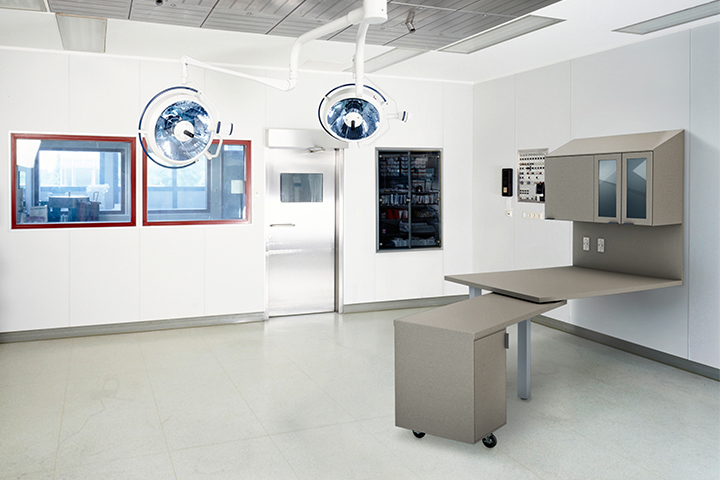Solid surface in OR environments
All health environments need care and attention to keep them safe for users, but operating rooms require a special level of upkeep. With each new patient comes a number of steps that must occur to ensure maximum cleanliness and security for the next person. However, OR surgeons often face high pressures to improve OR efficiency. “For health care facilities, time is money — and that is especially true in the operating room (OR),” an article in Health Facilities Management says. “ORs often feel a lot of pressure for quick turnover times to help increase the number of surgeries they execute per day.”
Solid surface can reconcile these conflicting sides. Its many features can help to both maintain a clean environment and maximize efficiency. Here are four aspects of the material that show why including solid surface in OR environments is a smart choice. [vc_separator type=”transparent” up=”20″ down=”20″]
Cleanable
Sterility is essential in ORs. Maintaining maximum cleanliness helps avoid serious infection by bacteria and microbes. A material that effectively wards off bacteria and is easily cleaned and maintained is extremely important to patient health and OR efficiency, which is why solid surface is ideal in ORs.
First, it’s nonporous. Solid surface is, as the name suggests, solid, so germs and substances can’t slip through the cracks as they can in other materials, such as woods and plastics. The nonporous nature also makes it very easily cleaned. The material is stain resistant, which makes cleaning the space before a new patient comes in quick.
Also, solid surface is bacteria resistant. Because it is nonporous, it doesn’t harbor bacteria growth, and this helps keep the risk of infection to a minimum and further improves the efficiency in cleaning.[vc_separator type=”transparent” up=”20″ down=”20″]
[vc_separator type=”transparent” up=”20″ down=”20″]Durable
Improving OR efficiency includes selecting materials that will offer a good return on your investment. ORs see numerous patients a day. They’re heavily cleaned between each surgery, and they face a particularly heavy wash at the end of each day. The materials in ORs, then, must be able to stand up to this intense use. It can’t break down when it gets wet. It must be easily repaired. It should last for years without severe problems.
Many materials, such as plastic laminate, are therefore not appropriate for ORs. They easily malfunction in water, and they simply cannot hold up to the heavy wear and tear ORs wreak on them.
Solid surface can. Its nonporous nature makes it resistant to water damage, so even after 50 wipe-downs in one day, solid surface maintains its function. Though not easily damaged, solid surface is easily repaired should any damage occur to this strong material. Scratches and dents can be quickly sanded and buffed out, and products, such as some of Shield’s casework, are modular, so a break in one part doesn’t necessitate an entire new product. The material has been proven to last for decades despite heavy use, making it the perfect material for an environment that faces such high traffic and heavy cleaning day in and day out.[vc_separator type=”transparent” up=”20″ down=”20″]
Improved Aesthetic
Getting a surgery isn’t fun, and giving one isn’t necessarily a walk in the park either. Using materials that contribute to a less stressful environment can have immense effects on both the patient and the surgeons. Rather than choosing materials such as stainless steel that only come in an uninviting industrial gray color, select solid surface. Its natural, soft white color makes the space more welcoming for patients, and the brighter color can create less stress for clinicians. Moreover, solid surface is available in a variety of colors, so it can be customized to make an even more inviting space. [vc_separator type=”transparent” up=”20″ down=”20″]
[vc_separator type=”transparent” up=”20″ down=”20″]Stainless Steel Replacement
A common material in ORs, stainless steel has many of the same benefits as solid surface. Like solid surface, stainless steel is nonporous, so it is bacteria resistant and easily cleaned, and it’s a strong material that can withstand heavy use. However, it is very expensive. Solid surface has the same functionality as stainless steel and comes with all of the benefits, but it doesn’t cost nearly as much. It’s typically over 30 percent cheaper than stainless steel, but it still brings with it cleanliness and durability.
[vc_separator type=”transparent” up=”20″ down=”20″]
The material’s cleanliness, durability, high aesthetics and cheaper price show why including solid surface in OR environments is a smart choice for both the patients and the clinicians. It’s nonporous nature protects patients, and its durability and cleanable surface maximizes efficiency. Don’t choose a material that hinders success or wastes money. Select the one that makes the experience better for clinicians and patients alike.







Pass throughs: solid surface vs stainless steel | Shield Casework | Nov 14, 2016 at 8:02 pm
[…] clean rooms necessitate the best materials that will maintain cleanliness, boost efficiency and save time and money. Pass throughs are common […]